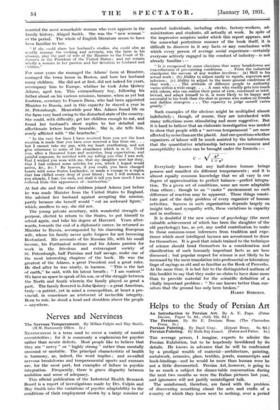Helps to the Study of Persian Art
The Persians. By Sir E. Denison Ross. (The Clarendon Press. 5s. ) Persian Painting. By Basil Gray. (Ernest Benn. 6s. 6d.) Persian Painting. By Pilulk Raj Anand. (Faber and Faber. is.)
THE average person, I imagine, expects to admire the Persian Exhibition, but to be hopelessly bewildered by its details. He knows in advance that he will be confronted by a prodigal wealth of material—architecture, painting, metalwork, ceramics, glass, textiles, jewels, manuscripts and book-bindings—and he would be more than human were he not a little disconcerted. Persian Art, however, is going to be as much a subject for dinner-table conversation during the next two months as were the Italian pictures last year, and ignorance will not justify unintelligent talk.
The uninformed, therefore, are faced with the problem of discovering something about the arts and crafts of a country- of which they know next to nothing, over a period of two thousand years. As a start, even before Mr. A. U. Pope's Introduction to Persian Art, I recommend The Persians, by Sir E. Denison Ross. This little book—so short, so brilliant and so readable—will carry even the laziest over the sticks of Persian Art without accident. For conciseness the chapters on literature and art could not be bettered, and those on the country and the people and on journeys through Persia succeed extraordinarily well in making Persia seem less of a distant and legendary land.
Mr. Pope, the Director of the International Exhibition of Persian Art, has attempted a task before which the bravest might quail. His canvas is so vast and the details are so intricate that his lucid exposition and marshalling of facts becomes something of an accomplishment. When one con- siders that the subjects of each of his twelve chapters might not only occupy a volume in itself but provide the material for the work of a lifetime, the magnitude of his task becomes apparent. The illustrations of architecture, sculpture, bronzes, carpets, textiles, ceramics, caligraphy, miniatures, landscapes and gardens provide a well-chosen background for the text. Mr. Pope writes simply and with authority, eschewing tech- nicalities and the various pitfalls into which an expert is so liable to fall when writing a popular book. An Introduction to Persian Art is, of course, indispensable.
From these two books I would advise the student of Persian Art to go on to Mr. Basil Gray's Persian Painting. Mr. Gray, who is Assistant-Keeper in the Department of
Oriental Prints at the British Museum, has written a short and scholarly monograph on the various aspects of this wide branch of Persian Mt. Primed with the information which Mr. Gray has made so pleasantly accessible, the visitor to Gallery X and to the Architecture Gallery at Burlington House will find the miniatures not less charming, but infinitely more comprehensible. This book contains sixteen plates of paintings in English collections.
In addition, in the Criterion Miscellany, Messrs. Faber and Faber have issued an essay by Mr. Mulk Raj Anand on Persian Painting which should be read as a companion to Mr. Gray's book. Fortified by some or all of these volumes, the intending visitor at the Persian Exhibition should not find himself in too deep water. DAVID FINCIIA.M.



































 Previous page
Previous page